Recent Progress in Surface Acoustic Wave Sensors Based on Low-Dimensional Materials and Their Applications
Abstract
1. Introduction
2. Fundamental Principles and Mechanisms of SAW Sensors
2.1. Mechanisms of SAW Sensors
2.2. The Wave Modes of SAW Sensors
2.2.1. Rayleigh Waves
2.2.2. Shear Horizontal Waves
2.2.3. Love Waves
2.2.4. Lamb Waves
2.3. Performance Indicators of SAW Sensors
3. Materials for Sensing Layer of SAW Devices
3.1. Zero-Dimensional Materials
3.2. One-Dimensional Materials
3.3. Two-Dimension Materials
4. Coating Techniques for Low-Dimensional Materials
4.1. Spin Coating
4.2. Inkjet Printing
4.3. Chemical Vapor Deposition
4.4. Pulsed Laser Deposition
5. Applications of SAW Sensors Based on Low-Dimensional Materials
5.1. Gas Sensors
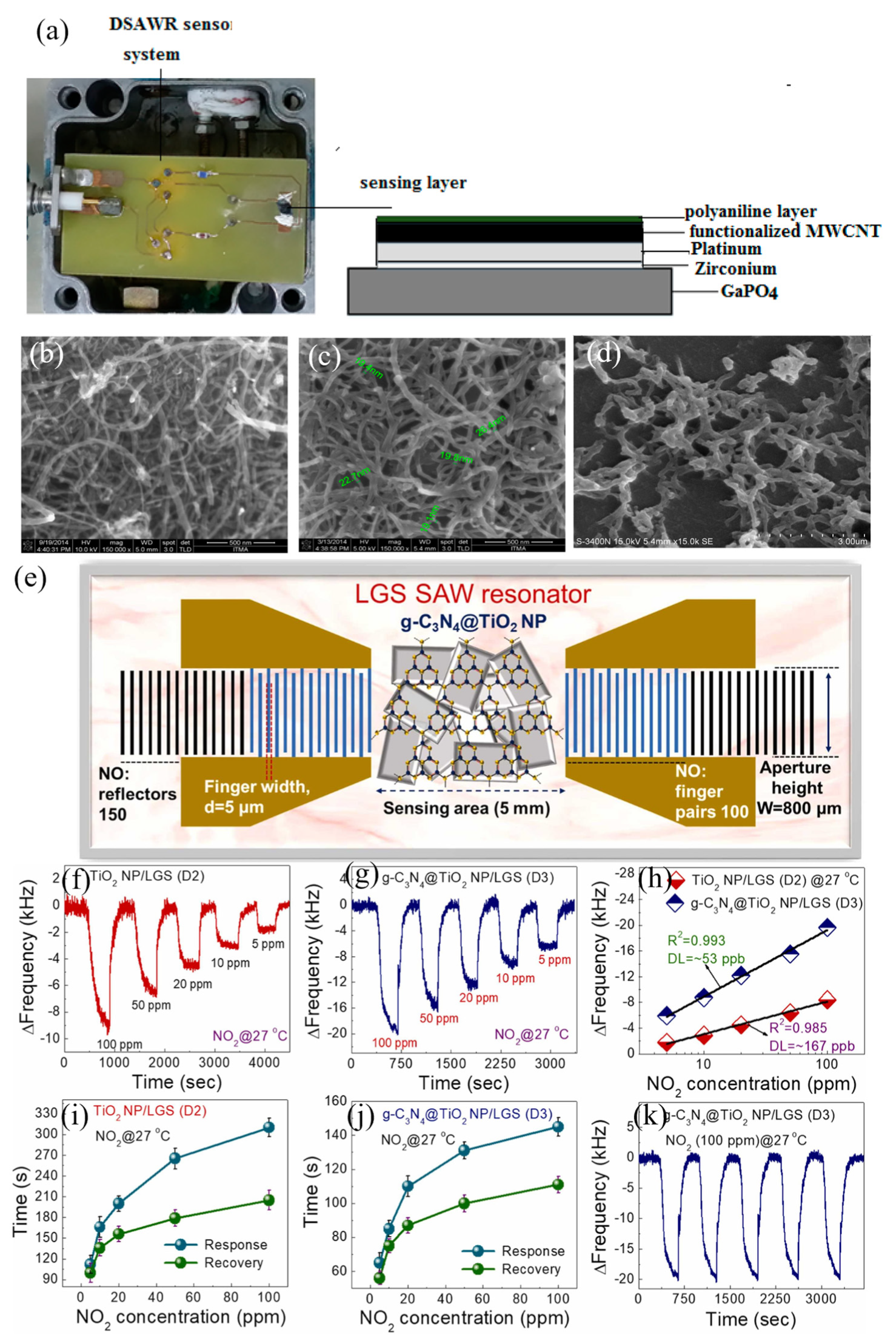
5.2. UV Sensors
5.3. Humidity Sensors
5.4. Biosensors
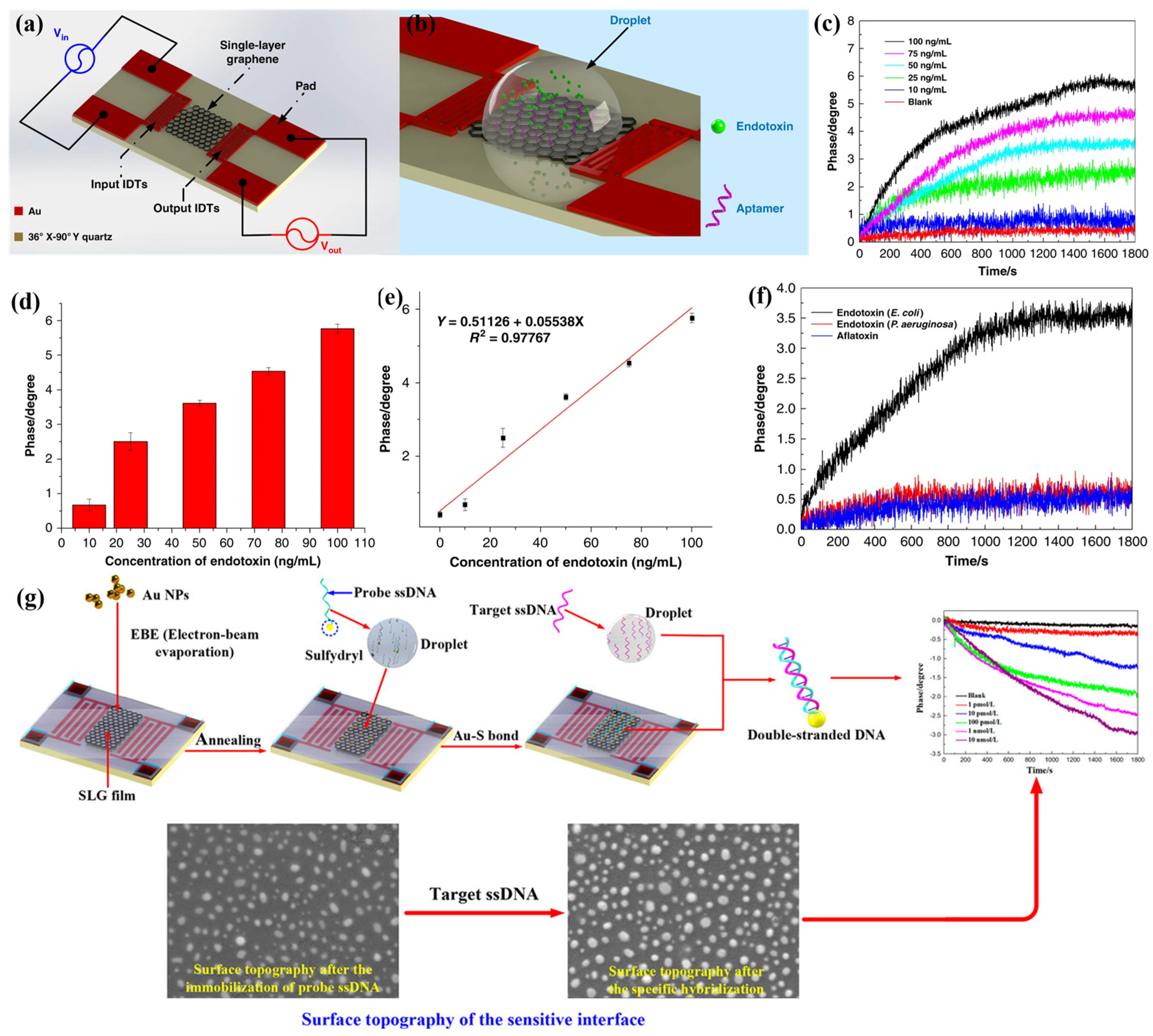
6. Conclusions and Future Perspectives
6.1. Conclusions
6.2. Future Perspectives
Author Contributions
Funding
Institutional Review Board Statement
Informed Consent Statement
Data Availability Statement
Conflicts of Interest
References
- Xu, K.; Lu, Y.; Takei, K. Multifunctional Skin-Inspired Flexible Sensor Systems for Wearable Electronics. Adv. Mater. Technol. 2019, 4, 1800628. [Google Scholar] [CrossRef]
- Zhang, K.; Wang, Y.; Yang, Y. Structure Design and Performance of Hybridized Nanogenerators. Adv. Funct. Mater. 2019, 29, 1806435. [Google Scholar] [CrossRef]
- Hua, Q.; Sun, J.; Liu, H.; Bao, R.; Yu, R.; Zhai, J.; Pan, C.; Wang, Z.L. Skin-Inspired Highly Stretchable and Conformable Matrix Networks for Multifunctional Sensing. Nat. Commun. 2018, 9, 244. [Google Scholar] [CrossRef] [PubMed]
- Wu, J.; Wu, Z.; Ding, H.; Wei, Y.; Yang, X.; Li, Z.; Yang, B.-R.; Liu, C.; Qiu, L.; Wang, X. Multifunctional and High-Sensitive Sensor Capable of Detecting Humidity, Temperature, and Flow Stimuli Using an Integrated Microheater. ACS Appl. Mater. Interfaces 2019, 11, 43383–43392. [Google Scholar] [CrossRef] [PubMed]
- Länge, K. Bulk and Surface Acoustic Wave Sensor Arrays for Multi-Analyte Detection: A Review. Sensors 2019, 19, 5382. [Google Scholar] [CrossRef] [PubMed]
- Cruz, C.; Matatagui, D.; Ramírez, C.; Badillo-Ramirez, I.; de la O-Cuevas, E.; Saniger, J.M.; Horrillo, M.C. Carbon SH-SAW-Based Electronic Nose to Discriminate and Classify Sub-Ppm NO2. Sensors 2022, 22, 1261. [Google Scholar] [CrossRef] [PubMed]
- Agostini, M.; Cecchini, M. Ultra-High-Frequency (UHF) Surface-Acoustic-Wave (SAW) Microfluidics and Biosensors. Nanotechnology 2021, 32, 312001. [Google Scholar] [CrossRef]
- Schmid, L.; Weitz, D.A.; Franke, T. Sorting Drops and Cells with Acoustics: Acoustic Microfluidic Fluorescence-Activated Cell Sorter. Lab Chip 2014, 14, 3710–3718. [Google Scholar] [CrossRef]
- Hassan, M.M.; Sium, F.S.; Islam, F.; Choudhury, S.M. A Review on Plasmonic and Metamaterial Based Biosensing Platforms for Virus Detection. Sens. Bio-Sens. Res. 2021, 33, 100429. [Google Scholar] [CrossRef]
- Jiang, Y.; Tan, C.Y.; Tan, S.Y.; Wong, M.S.F.; Chen, Y.F.; Zhang, L.; Yao, K.; Gan, S.K.E.; Verma, C.; Tan, Y.-J. SAW Sensor for Influenza A Virus Detection Enabled with Efficient Surface Functionalization. Sens. Actuat. B-Chem. 2015, 209, 78–84. [Google Scholar] [CrossRef]
- Zhang, J.; Zhang, X.; Wei, X.; Xue, Y.; Wan, H.; Wang, P. Recent Advances in Acoustic Wave Biosensors for the Detection of Disease-Related Biomarkers: A Review. Anal. Chim. Acta 2021, 1164, 338321. [Google Scholar] [CrossRef]
- Gray, E.R.; Turbé, V.; Lawson, V.E.; Page, R.H.; Cook, Z.C.; Ferns, R.B.; Nastouli, E.; Pillay, D.; Yatsuda, H.; Athey, D.; et al. Ultra-Rapid, Sensitive and Specific Digital Diagnosis of HIV with a Dual-Channel SAW Biosensor in a Pilot Clinical Study. NPJ Digital Med. 2018, 1, 35. [Google Scholar] [CrossRef]
- Mandal, D.; Banerjee, S. Surface Acoustic Wave (SAW) Sensors: Physics, Materials, and Applications. Sensors 2022, 22, 820. [Google Scholar] [CrossRef] [PubMed]
- Damasceno, B.S.; Horta, I.M.; de Oliveira, R.S.; Pereira, R.M.; Schatkoski, V.M.; Bacher, G.; Leite, D.M. Recent Improvements on Surface Acoustic Wave Sensors Based on Graphenic Nanomaterials. Mat. Sci. Semicon. Proc. 2023, 167, 107811. [Google Scholar] [CrossRef]
- Li, D.; Feng, Y.; Zhou, L.; Ye, Z.; Wang, J.; Ying, Y.; Ruan, C.; Wang, R.; Li, Y. Label-Free Capacitive Immunosensor Based on Quartz Crystal Au Electrode for Rapid and Sensitive Detection of Escherichia Coli O157:H7. Anal. Chim. Acta 2011, 687, 89–96. [Google Scholar] [CrossRef]
- Liu, X.; Wang, J.-Y.; Mao, X.-B.; Ning, Y.; Zhang, G.-J. Single-Shot Analytical Assay Based on Graphene-Oxide-Modified Surface Acoustic Wave Biosensor for Detection of Single-Nucleotide Polymorphisms. Anal. Chem. 2015, 87, 9352–9359. [Google Scholar] [CrossRef] [PubMed]
- Branch, D.W.; Hayes, D.C.; Ricken, J.B. Handheld Biosensor for COVID-19 Screening. Sandia National Laboratory Report No. SAND-2020-10358. September 2020. Available online: https://www.osti.gov/biblio/1671376/ (accessed on 1 September 2020).
- Chivukula, V.S.; Ciplys, D.; Kim, J.H.; Rimeika, R.; Xu, J.M.; Shur, M.S. Surface Acoustic Wave Response to Optical Absorption by Graphene Composite Film. IEEE T Ultrason. Ferr. 2012, 59, 265–270. [Google Scholar] [CrossRef] [PubMed]
- Guo, Y.J.; Zhao, C.; Zhou, X.S.; Li, Y.; Zu, X.T.; Gibson, D.; Fu, Y.Q. Ultraviolet Sensing Based on Nanostructured ZnO/Si Surface Acoustic Wave Devices. Smart Mater. Struct. 2015, 24, 125015. [Google Scholar] [CrossRef]
- Li, C.; Kan, H.; Luo, J.; Fu, C.; Zhou, J.; Liu, X.; Wang, W.; Wei, Q.; Fu, Y. A High Performance Surface Acoustic Wave Visible Light Sensor Using Novel Materials: Bi2S3 Nanobelts. RSC Adv. 2020, 10, 8936–8940. [Google Scholar] [CrossRef]
- Oh, H.; Lee, K.J.; Baek, J.; Yang, S.S.; Lee, K. Development of a High Sensitive pH Sensor Based on Shear Horizontal Surface Acoustic Wave with ZnO Nanoparticles. Microelectron. Eng. 2013, 111, 154–159. [Google Scholar] [CrossRef]
- Wang, T.; Green, R.; Guldiken, R.; Mohapatra, S.; Mohapatra, S. Multiple-Layer Guided Surface Acoustic Wave (SAW)-Based pH Sensing in Longitudinal FiSS-Tumoroid Cultures. Biosens. Bioelectron. 2019, 124–125, 244–252. [Google Scholar] [CrossRef] [PubMed]
- Jin, P.; Fu, J.; Wang, F.; Zhang, Y.; Wang, P.; Liu, X.; Jiao, Y.; Li, H.; Chen, Y.; Ma, Y.; et al. A Flexible, Stretchable System for Simultaneous Acoustic Energy Transfer and Communication. Sci. Adv. 2021, 7, eabg2507. [Google Scholar] [CrossRef] [PubMed]
- Kim, Y.; Suh, J.M.; Shin, J.; Liu, Y.; Yeon, H.; Qiao, K.; Kum, H.S.; Kim, C.; Lee, H.E.; Choi, C.; et al. Chip-Less Wireless Electronic Skins by Remote Epitaxial Freestanding Compound Semiconductors. Science 2022, 377, 859–864. [Google Scholar] [CrossRef] [PubMed]
- Zhou, J.; Guo, Y.; Wang, Y.; Ji, Z.; Zhang, Q.; Zhuo, F.; Luo, J.; Tao, R.; Xie, J.; Reboud, J.; et al. Flexible and Wearable Acoustic Wave Technologies. Appl. Phys. Rev. 2023, 10, 021311. [Google Scholar] [CrossRef]
- Chen, Y.; Shu, Z.; Zhang, S.; Zeng, P.; Liang, H.; Zheng, M.; Duan, H. Sub-10 Nm Fabrication: Methods and Applications. Int. J. Extrem. Manuf. 2021, 3, 032002. [Google Scholar] [CrossRef]
- Zhang, Y.; Tan, Y.-W.; Stormer, H.L.; Kim, P. Experimental Observation of the Quantum Hall Effect and Berry’s Phase in Graphene. Nature 2005, 438, 201–204. [Google Scholar] [CrossRef]
- Stoller, M.D.; Park, S.; Zhu, Y.; An, J.; Ruoff, R.S. Graphene-Based Ultracapacitors. Nano Lett. 2008, 8, 3498–3502. [Google Scholar] [CrossRef]
- Buckley, D.J.; Black, N.C.G.; Castanon, E.G.; Melios, C.; Hardman, M.; Kazakova, O. Frontiers of Graphene and 2D Material-Based Gas Sensors for Environmental Monitoring. 2D Mater. 2020, 7, 032002. [Google Scholar] [CrossRef]
- Chhowalla, M.; Shin, H.S.; Eda, G.; Li, L.-J.; Loh, K.P.; Zhang, H. The Chemistry of Two-Dimensional Layered Transition Metal Dichalcogenide Nanosheets. Nat. Chem. 2013, 5, 263–275. [Google Scholar] [CrossRef] [PubMed]
- Huang, X.; Zeng, Z.; Zhang, H. Metal Dichalcogenide Nanosheets: Preparation, Properties and Applications. Chem. Soc. Rev. 2013, 42, 1934–1946. [Google Scholar] [CrossRef]
- Chhowalla, M.; Liu, Z.; Zhang, H. Two-Dimensional Transition Metal Dichalcogenide (TMD) Nanosheets. Chem. Soc. Rev. 2015, 44, 2584–2586. [Google Scholar] [CrossRef] [PubMed]
- Osada, M.; Sasaki, T. Exfoliated Oxide Nanosheets: New Solution to Nanoelectronics. J. Mater. Chem. 2009, 19, 2503–2511. [Google Scholar] [CrossRef]
- Pawar, K.K.; Kumar, A.; Mirzaei, A.; Kumar, M.; Kim, H.W.; Kim, S.S. 2D Nanomaterials for Realization of Flexible and Wearable Gas Sensors: A Review. Chemosphere 2024, 352, 141234. [Google Scholar] [CrossRef]
- Bhati, V.S.; Kumar, M.; Banerjee, R. Gas Sensing Performance of 2D Nanomaterials/Metal Oxide Nanocomposites: A Review. J. Mater. Chem. C 2021, 9, 8776–8808. [Google Scholar] [CrossRef]
- Zhang, H. Ultrathin Two-Dimensional Nanomaterials. ACS Nano 2015, 9, 9451–9469. [Google Scholar] [CrossRef] [PubMed]
- Lee, C.; Wei, X.; Kysar, J.W.; Hone, J. Measurement of the Elastic Properties and Intrinsic Strength of Monolayer Graphene. Science 2008, 321, 385–388. [Google Scholar] [CrossRef]
- Varghese, S.S.; Varghese, S.H.; Swaminathan, S.; Singh, K.K.; Mittal, V. Two-Dimensional Materials for Sensing: Graphene and Beyond. Electronics 2015, 4, 651–687. [Google Scholar] [CrossRef]
- Lamanna, L. Recent Progress in Polymeric Flexible Surface Acoustic Wave Devices: Materials, Processing, and Applications. Adv. Mater. Technol. 2023, 8, 2300362. [Google Scholar] [CrossRef]
- Yin, H.; Cao, Y.; Marelli, B.; Zeng, X.; Mason, A.J.; Cao, C. Soil Sensors and Plant Wearables for Smart and Precision Agriculture. Adv. Mater. 2021, 33, 2007764. [Google Scholar] [CrossRef]
- Kumar, A.; Prajesh, R. The Potential of Acoustic Wave Devices for Gas Sensing Applications. Sens. Actuat. A-Phys. 2022, 339, 113498. [Google Scholar] [CrossRef]
- Weser, R.; Winkler, A.; Weihnacht, M.; Menzel, S.; Schmidt, H. The Complexity of Surface Acoustic Wave Fields Used for Microfluidic Applications. Ultrasonics 2020, 106, 106160. [Google Scholar] [CrossRef] [PubMed]
- Qu, S.; Sheng, P. Microwave and Acoustic Absorption Metamaterials. Phys. Rev. Appl. 2022, 17, 047001. [Google Scholar] [CrossRef]
- Fu, Y.Q.; Luo, J.K.; Nguyen, N.T.; Walton, A.J.; Flewitt, A.J.; Zu, X.T.; Li, Y.; McHale, G.; Matthews, A.; Iborra, E.; et al. Advances in Piezoelectric Thin Films for Acoustic Biosensors, Acoustofluidics and Lab-on-Chip Applications. Prog. Mater. Sci. 2017, 89, 31–91. [Google Scholar] [CrossRef]
- Oh, H.; Lee, K.; Eun, K.; Choa, S.-H.; Yang, S.S. Development of a High-Sensitivity Strain Measurement System Based on a SH SAW Sensor. J. Micromech. Microeng. 2012, 22, 025002. [Google Scholar] [CrossRef]
- Kondoh, J.; Matsui, Y.; Shiokawa, S.; Wlodarski, W.B. Enzyme-Immobilized SH-SAW Biosensor. Sens. Actuat. B-Chem. 1994, 20, 199–203. [Google Scholar] [CrossRef]
- Newton, M.I.; McHale, G.; Martin, F. Experimental Study of Love Wave Devices with Thick Guiding Layers. Sens. Actuat. A-Phys. 2004, 109, 180–185. [Google Scholar] [CrossRef]
- Zhang, F.; Li, S.; Cao, K.; Wang, P.; Su, Y.; Zhu, X.; Wan, Y. A Microfluidic Love-Wave Biosensing Device for PSA Detection Based on an Aptamer Beacon Probe. Sensors 2015, 15, 13839–13850. [Google Scholar] [CrossRef] [PubMed]
- Lee, S.; Kim, K.-B.; Kim, Y.-I. Love Wave SAW Biosensors for Detection of Antigen-Antibody Binding and Comparison with SPR Biosensor. Food Sci. Biotechnol. 2011, 20, 1413–1418. [Google Scholar] [CrossRef]
- Roach, P.; Atherton, S.; Doy, N.; McHale, G.; Newton, M.I. SU-8 Guiding Layer for Love Wave Devices. Sensors 2007, 7, 2539–2547. [Google Scholar] [CrossRef]
- McHale, G.; Newton, M.I.; Martin, F.; Gizeli, E.; Melzak, K.A. Resonant Conditions for Love Wave Guiding Layer Thickness. Appl. Phys. Lett. 2001, 79, 3542–3543. [Google Scholar] [CrossRef]
- Trivedi, S.; Nemade, H.B. Finite Element Simulation of Love Wave Resonator for DNA Detection. Int. J. Adv. Eng. Sci. Appl. Math. 2015, 7, 210–218. [Google Scholar] [CrossRef]
- Lamb, H. On Waves in an Elastic Plate. Proc. R. Soc. Lond. Ser. A 1917, 93, 114–128. [Google Scholar]
- Zhou, J.; Ji, Z.; Guo, Y.; Liu, Y.; Zhuo, F.; Zheng, Y.; Gu, Y.; Fu, Y.; Duan, H. Strategy to Minimize Bending Strain Interference for Flexible Acoustic Wave Sensing Platform. NPJ Flex. Electron. 2022, 6, 84. [Google Scholar] [CrossRef]
- Ahmed, I.; Rawat, U.; Chen, J.-T.; Weinstein, D. Super-High-Frequency Low-Loss Sezawa Mode SAW Devices in a GaN/SiC Platform. IEEE Trans. Ultrason. Ferr. 2023, 70, 291–301. [Google Scholar] [CrossRef] [PubMed]
- Hara, M.; Kuypers, J.; Abe, T.; Esashi, M. Surface Micromachined AlN Thin Film 2 GHz Resonator for CMOS Integration. Sens. Actuat. A-Phys. 2005, 117, 211–216. [Google Scholar] [CrossRef]
- Hamidon, M.N.; Yunusa, Z.; Hamidon, M.N.; Yunusa, Z. Sensing Materials for Surface Acoustic Wave Chemical Sensors. In Progresses in Chemical Sensor; IntechOpen: London, UK, 2016; pp. 161–179. [Google Scholar]
- Hung, C.M.; Van Duy, N.; Van Quang, V.; Van Toan, N.; Van Hieu, N.; Hoa, N.D. Facile Synthesis of Ultrafine rGO/WO3 Nanowire Nanocomposites for Highly Sensitive Toxic NH3 Gas Sensors. Mater. Res. Bull. 2020, 125, 110810. [Google Scholar] [CrossRef]
- Vargas-Bernal, R. Electrical Properties of Two-Dimensional Materials Used in Gas Sensors. Sensors 2019, 19, 1295. [Google Scholar] [CrossRef]
- Gogola, J.L.; Martins, G.; Gevaerd, A.; Blanes, L.; Cardoso, J.; Marchini, F.K.; Banks, C.E.; Bergamini, M.F.; Marcolino-Junior, L.H. Label-Free Aptasensor for P24-HIV Protein Detection Based on Graphene Quantum Dots as an Electrochemical Signal Amplifier. Anal. Chim. Acta 2021, 1166, 338548. [Google Scholar] [CrossRef]
- Feng, L.; Liu, G.; Guo, P.; Jiang, Y.; Ma, X.; Chen, Y.; Luo, J. High-Sensitivity Non-Cooled near-Infrared Detector Based on Lithium Niobate Surface Acoustic Wave Resonators Combined with MXene Ti3C2Tx Quantum Dot Thin Films. Opt. Express 2023, 31, 25829–25839. [Google Scholar] [CrossRef]
- Li, H.; Li, M.; Kan, H.; Li, C.; Quan, A.; Fu, C.; Luo, J.; Liu, X.; Wang, W.; Yang, Z.; et al. Surface Acoustic Wave NO2 Sensors Utilizing Colloidal SnS Quantum Dot Thin Films. Surf. Coat. Tech. 2019, 362, 78–83. [Google Scholar] [CrossRef]
- Pasupuleti, K.S.; Chougule, S.S.; Vidyasagar, D.; Bak, N.; Jung, N.; Kim, Y.-H.; Lee, J.-H.; Kim, S.-G.; Kim, M.-D. UV Light Driven High-Performance Room Temperature Surface Acoustic Wave NH3 Gas Sensor Using Sulfur-Doped g-C3N4 Quantum Dots. Nano Res. 2023, 16, 7682–7695. [Google Scholar] [CrossRef]
- Yin, C.; Wu, J.; Zhou, J.; Zhang, D.; Liu, Z.; Liu, X.; Liu, L.; Zhan, Z.; Garner, S.; Fu, Y. Enhancing the Sensitivity of Flexible Acoustic Wave Ultraviolet Photodetector with Graphene-Quantum-Dots Decorated ZnO Nanowires. Sens. Actuators A Phys. 2021, 321, 112590. [Google Scholar] [CrossRef]
- Dhar, S.; Majumder, T.; Mondal, S.P. Graphene Quantum Dot-Sensitized ZnO Nanorod/Polymer Schottky Junction UV Detector with Superior External Quantum Efficiency, Detectivity, and Responsivity. ACS Appl. Mater. Interfaces 2016, 8, 31822–31831. [Google Scholar] [CrossRef]
- Constantinoiu, I.; Viespe, C. Hydrogen Detection with SAW Polymer/Quantum Dots Sensitive Films. Sensors 2019, 19, 4481. [Google Scholar] [CrossRef] [PubMed]
- Xu, Q.; Dai, Y.; Peng, Y.; Hong, L.; Yang, N.; Wang, Z. Recent Development of Multifunctional Sensors Based on Low-Dimensional Materials. Sensors 2021, 21, 7727. [Google Scholar] [CrossRef] [PubMed]
- Marcu, A.; Viespe, C. Surface Acoustic Wave Sensors for Hydrogen and Deuterium Detection. Sensors 2017, 17, 1417. [Google Scholar] [CrossRef] [PubMed]
- Peng, W.; He, Y.; Wen, C.; Ma, K. Surface Acoustic Wave Ultraviolet Detector Based on Zinc Oxide Nanowire Sensing Layer. Sens. Actuat. A-Phys. 2012, 184, 34–40. [Google Scholar] [CrossRef]
- Marcu, A.; Viespe, C. Laser-Grown ZnO Nanowires for Room-Temperature SAW-Sensor Applications. Sensors Actuat. B-Chem. 2015, 208, 1–6. [Google Scholar] [CrossRef]
- Wang, W.; Liu, X.; Mei, S.; Jia, Y.; Liu, M.; Xue, X.; Yang, D. Development of a Pd/Cu Nanowires Coated SAW Hydrogen Gas Sensor with Fast Response and Recovery. Sensors Actuat. B-Chem. 2019, 287, 157–164. [Google Scholar] [CrossRef]
- Li, W.; Guo, Y.; Tang, Y.; Zu, X.; Ma, J.; Wang, L.; Fu, Y.Q. Room-Temperature Ammonia Sensor Based on ZnO Nanorods Deposited on ST-Cut Quartz Surface Acoustic Wave Devices. Sensors 2017, 17, 1142. [Google Scholar] [CrossRef]
- Guo, Y.J.; Zhang, J.; Zhao, C.; Ma, J.Y.; Pang, H.F.; Hu, P.A.; Placido, F.; Gibson, D.; Zu, X.T.; Zu, H.Y.; et al. Characterization and Humidity Sensing of ZnO/42° YX LiTaO3 Love Wave Devices with ZnO Nanorods. Mater. Res. Bull. 2013, 48, 5058–5063. [Google Scholar] [CrossRef]
- Sayago, I.; Fernández, M.J.; Fontecha, J.L.; Horrillo, M.C.; Vera, C.; Obieta, I.; Bustero, I. Surface Acoustic Wave Gas Sensors Based on Polyisobutylene and Carbon Nanotube Composites. Sensors Actuat. B-Chem. 2011, 156, 1–5. [Google Scholar] [CrossRef]
- Ji, J.; Pang, Y.; Li, D.; Huang, Z.; Zhang, Z.; Xue, N.; Xu, Y.; Mu, X. An Aptamer-Based Shear Horizontal Surface Acoustic Wave Biosensor with a CVD-Grown Single-Layered Graphene Film for High-Sensitivity Detection of a Label-Free Endotoxin. Microsyst. Nanoeng. 2020, 6, 4. [Google Scholar] [CrossRef]
- Okuda, S.; Ono, T.; Kanai, Y.; Ikuta, T.; Shimatani, M.; Ogawa, S.; Maehashi, K.; Inoue, K.; Matsumoto, K. Graphene Surface Acoustic Wave Sensor for Simultaneous Detection of Charge and Mass. ACS Sens. 2018, 3, 200–204. [Google Scholar] [CrossRef] [PubMed]
- Dinu, L.A.; Buiculescu, V.; Baracu, A.M. Recent Progress on Nanomaterials for NO2 Surface Acoustic Wave Sensors. Nanomaterials 2022, 12, 2120. [Google Scholar] [CrossRef] [PubMed]
- Li, D.; Le, X.; Pang, J.; Xie, J. A Saw Hydrogen Sensor Based on the Composite of Graphene Oxide and Palladium Nanoparticles. In Proceedings of the 2019 IEEE 32nd International Conference on Micro Electro Mechanical Systems (MEMS), Seoul, Republic of Korea, 27–31 January 2019. [Google Scholar]
- Lim, J.-B.; Reddeppa, M.; Nam, D.; Pasupuleti, K.S.; Bak, N.-H.; Kim, S.-G.; Cho, H.D.; Kim, M.-D. Surface Acoustic Device for High Response NO2 Gas Sensor Using P-Phenylenediamine-Reduced Graphene Oxide Nanocomposite Coated on Langasite. Smart Mater. Struct. 2021, 30, 095016. [Google Scholar] [CrossRef]
- Zhou, P.; Chen, C.; Wang, X.; Hu, B.; San, H. 2-Dimentional Photoconductive MoS2 Nanosheets Using in Surface Acoustic Wave Resonators for Ultraviolet Light Sensing. Sens. Actuat. A-Phys. 2018, 271, 389–397. [Google Scholar] [CrossRef]
- Lu, L.; Liu, J.; Li, Q.; Yi, Z.; Liu, J.; Wang, X.; Chen, X.; Yang, B. High Performance SnO2/MoS2-Based Surface Acoustic Wave Humidity Sensor With Good Linearity. IEEE Sens. J. 2019, 19, 11027–11033. [Google Scholar] [CrossRef]
- Naguib, M.; Kurtoglu, M.; Presser, V.; Lu, J.; Niu, J.; Heon, M.; Hultman, L.; Gogotsi, Y.; Barsoum, M.W. Two-Dimensional Nanocrystals Produced by Exfoliation of Ti3AlC2. Adv. Mater. 2011, 23, 4248–4253. [Google Scholar] [CrossRef]
- Li, X.; Feng, Y.; Long, J.; Lv, H.; Guo, Y.; Zu, X. MXene-Activated Graphene Oxide Enhancing NO2 Capture and Detection of Surface Acoustic Wave Sensors. Sensors Actuat. B-Chem. 2024, 401, 135006. [Google Scholar] [CrossRef]
- Pasupuleti, K.S.; Thomas, A.M.; Vidyasagar, D.; Rao, V.N.; Yoon, S.-G.; Kim, Y.-H.; Kim, S.-G.; Kim, M.-D. ZnO@Ti3C2Tx MXene Hybrid Composite-Based Schottky-Barrier-Coated SAW Sensor for Effective Detection of Sub-ppb-Level NH3 at Room Temperature under UV Illumination. ACS Mater. Lett. 2023, 5, 2739–2746. [Google Scholar] [CrossRef]
- Glinsek, S.; Song, L.; Kovacova, V.; Mahjoub, M.A.; Godard, N.; Girod, S.; Biagi, J.-L.; Quintana, R.; Schleeh, T.; Guedra, M.; et al. Inkjet-Printed Piezoelectric Thin Films for Transparent Haptics. Adv. Mater. Tech. 2022, 7, 2200147. [Google Scholar] [CrossRef]
- Nikolaou, I.; Hallil, H.; Conédéra, V.; Deligeorgis, G.; Dejous, C.; Rebiere, D. Inkjet-printed graphene oxide thin layers on love wave devices for humidity and vapor detection. IEEE Sens. J. 2016, 16, 7620–7627. [Google Scholar] [CrossRef]
- Di, W.; Liu, F.; Lin, T.; Kong, H.; Meng, C.; Zhang, W.; Chen, Y.; Hou, Y. Influence of oxygen partial pressure on structural and electrical properties of Mn1.56Co0.96Ni0.48O4 thin films deposited by pulsed laser deposition. Appl. Surf. Sci. 2018, 447, 287–291. [Google Scholar] [CrossRef]
- Meng, L.; Wang, Z.; Yang, L.; Ren, W.; Liu, W.; Zhang, Z.; Yang, T.; Dos Santos, M.P. A detailed study on the Fe-doped TiO2 thin films induced by pulsed laser deposition route. Appl. Surf. Sci. 2019, 474, 211–217. [Google Scholar] [CrossRef]
- Viespe, C.; Miu, D. Surface Acoustic Wave Sensor with Pd/ZnO Bilayer Structure for Room Temperature Hydrogen Detection. Sensors 2017, 17, 1529. [Google Scholar] [CrossRef]
- Constantinoiu, I.; Viespe, C. Development of Pd/TiO2 Porous Layers by Pulsed Laser Deposition for Surface Acoustic Wave H2 Gas Sensor. Nanomaterials 2020, 10, 760. [Google Scholar] [CrossRef]
- Aslam, M.Z.; Zhang, H.; Sreejith, V.S.; Naghdi, M.; Ju, S. Advances in the Surface Acoustic Wave Sensors for Industrial Applications: Potentials, Challenges, and Future Directions: A Review. Measurement 2023, 222, 113657. [Google Scholar] [CrossRef]
- Xu, S.; Li, C.; Li, H.; Li, M.; Qu, C.; Yang, B. Carbon Dioxide Sensors Based on a Surface Acoustic Wave Device with a Graphene–Nickel–L-Alanine Multilayer Film. J. Mater. Chem. C 2015, 3, 3882–3890. [Google Scholar] [CrossRef]
- Wang, Y.; Chyu, M.K.; Wang, Q.-M. Passive Wireless Surface Acoustic Wave CO2 Sensor with Carbon Nanotube Nanocomposite as an Interface Layer. Sens. Actuat. A-Phys. 2014, 220, 34–44. [Google Scholar] [CrossRef]
- Zhou, H.; Ramaraj, S.G.; Ma, K.; Sarker, M.S.; Liao, Z.; Tang, S.; Yamahara, H.; Tabata, H. Real-Time Detection of Acetone Gas Molecules at ppt Levels in an Air Atmosphere Using a Partially Suspended Graphene Surface Acoustic Wave Skin Gas Sensor. Nanoscale Adv. 2023, 5, 6999–7008. [Google Scholar] [CrossRef]
- Luo, W.; Fu, Q.; Zhou, D.; Deng, J.; Liu, H.; Yan, G. A Surface Acoustic Wave H2S Gas Sensor Employing Nanocrystalline SnO2 Thin Film. Sensors Actuat. B-Chem. 2013, 176, 746–752. [Google Scholar] [CrossRef]
- Hung, T.-T.; Chung, M.-H.; Chiu, J.-J.; Yang, M.-W.; Tien, T.-N.; Shen, C.-Y. Poly(4-Styrenesulfonic Acid) Doped Polypyrrole/Tungsten Oxide/Reduced Graphene Oxide Nanocomposite Films Based Surface Acoustic Wave Sensors for NO Sensing Behavior. Org. Electron. 2021, 88, 106006. [Google Scholar] [CrossRef]
- Liu, M.; Huang, X.; Song, Y.; Tang, J.; Cao, J.; Zhang, X.; Zhang, Q.; Wang, S.; Xu, T.; Kang, L.; et al. Ammonia Emission Control in China Would Mitigate Haze Pollution and Nitrogen Deposition, but Worsen Acid Rain. Proc. Natl. Acad. Sci. USA 2019, 116, 7760–7765. [Google Scholar] [CrossRef] [PubMed]
- Su, P.-G.; Yang, L.-Y. NH3 Gas Sensor Based on Pd/SnO2/RGO Ternary Composite Operated at Room-Temperature. Sensors Actuat. B-Chem. 2016, 223, 202–208. [Google Scholar] [CrossRef]
- Sun, X.; Chen, T.; Liang, Y.; Zhang, C.; Zhai, S.; Sun, J.; Wang, W. Enhanced Sensitivity of SAW Based Ammonia Sensor Employing GO-SnO2 Nanocomposites. Sensors Actuat. B-Chem. 2023, 375, 13288. [Google Scholar] [CrossRef]
- Mattoni, G.; de Jong, B.; Manca, N.; Tomellini, M.; Caviglia, A.D. Single-Crystal Pt-Decorated WO3 Ultrathin Films: A Platform for Sub-Ppm Hydrogen Sensing at Room Temperature. ACS Appl. Nano Mater. 2018, 1, 3446–3452. [Google Scholar] [CrossRef] [PubMed]
- Yunusa, Z.; Hamidon, M.N.; Ismail, A.; Isa, M.M.; Yaacob, M.H.; Rahmanian, S.; Ibrahim, S.A.; Shabaneh, A.A.A. Development of a Hydrogen Gas Sensor Using a Double Saw Resonator System at Room Temperature. Sensors 2015, 15, 4749–4765. [Google Scholar] [CrossRef] [PubMed]
- Jin, J.; Cui, B.; Cheng, L.; Xue, X.; Hu, A.; Liang, Y.; Wang, W. Dimensionality Regulation of ZIF Anti-Interference Layer for High-Selectivity and Fast-Response Hydrogen Sensing. Int. J. Hydrogen Energy 2024, 50, 903–911. [Google Scholar] [CrossRef]
- Kim, S.; Singh, G.; Lee, K. Development of Highly Sensitive and Stable Surface Acoustic Wave-Based Hydrogen Sensor and Its Interface Electronics. Adv. Mater. Technol. 2022, 7, 2200180. [Google Scholar] [CrossRef]
- Kim, S.S.; Kang, D.H.; Choi, D.H.; Yeo, M.S.; Kim, K.W. VOC Emission from Building Materials in Residential Buildings with Radiant Floor Heating Systems. Aerosol Air Qual. Res. 2012, 12, 1398–1408. [Google Scholar] [CrossRef]
- Mendell, M.J. Indoor Residential Chemical Emissions as Risk Factors for Respiratory and Allergic Effects in Children: A Review. Indoor Air 2007, 17, 259–277. [Google Scholar] [CrossRef] [PubMed]
- Nikolaou, I.; Hallil, H.; Dejous, C.; Rebière, D.; Deligeorgis, G.; Conedera, V. Inkjet—Printed Graphene Layer by Layer on SAW Devices for Gas Detection Applications. In Proceedings of the 2015 IEEE SENSORS, Busan, Republic of Korea, 1–4 November 2015. [Google Scholar]
- Li, Z.; Li, H.; Wu, Z.; Wang, M.; Luo, J.; Torun, H.; Hu, P.; Yang, C.; Grundmann, M.; Liu, X.; et al. Advances in Designs and Mechanisms of Semiconducting Metal Oxide Nanostructures for High-Precision Gas Sensors Operated at Room Temperature. Mater. Horiz. 2019, 6, 470–506. [Google Scholar] [CrossRef]
- Caliendo, C.; Verardi, P.; Verona, E.; D’Amico, A.; Natale, C.D.; Saggio, G.; Serafini, M.; Paolesse, R.; Huq, S.E. Advances in SAW-Based Gas Sensors. Smart Mater. Struct. 1997, 6, 689. [Google Scholar] [CrossRef]
- Jakubik, W.P. Surface Acoustic Wave-Based Gas Sensors. Thin Solid Films 2011, 520, 986–993. [Google Scholar] [CrossRef]
- Devkota, J.; Ohodnicki, P.R.; Greve, D.W. SAW Sensors for Chemical Vapors and Gases. Sensors 2017, 17, 801. [Google Scholar] [CrossRef] [PubMed]
- Guo, Y.J.; Long, G.D.; Tang, Y.L.; Wang, J.L.; Tang, Q.B.; Zu, X.T.; Ma, J.Y.; Du, B.; Torun, H.; Fu, Y.Q. Surface Acoustic Wave Ammonia Sensor Based on SiO2–SnO2 Composite Film Operated at Room Temperature. Smart Mater. Struct. 2020, 29, 095003. [Google Scholar] [CrossRef]
- Raj, V.B.; Singh, H.; Nimal, A.T.; Tomar, M.; Sharma, M.U.; Gupta, V. Effect of Metal Oxide Sensing Layers on the Distinct Detection of Ammonia Using Surface Acoustic Wave (SAW) Sensors. Sensors Actuat. B-Chem. 2013, 187, 563–573. [Google Scholar] [CrossRef]
- Raj, V.B.; Singh, H.; Nimal, A.T.; Sharma, M.U.; Tomar, M.; Gupta, V. Distinct Detection of Liquor Ammonia by ZnO/SAW Sensor: Study of Complete Sensing Mechanism. Sensors Actuat. B-Chem. 2017, 238, 83–90. [Google Scholar] [CrossRef]
- Cao, P.; Yang, Z.; Navale, S.T.; Han, S.; Liu, X.; Liu, W.; Lu, Y.; Stadler, F.J.; Zhu, D. Ethanol Sensing Behavior of Pd-Nanoparticles Decorated ZnO-Nanorod Based Chemiresistive Gas Sensors. Sensors Actuat. B-Chem. 2019, 298, 126850. [Google Scholar] [CrossRef]
- Huang, F.-C.; Chen, Y.-Y.; Wu, T.-T. A Room Temperature Surface Acoustic Wave Hydrogen Sensor with Pt Coated ZnO Nanorods. Nanotechnology 2009, 20, 065501. [Google Scholar] [CrossRef]
- Abraham, N.; Reshma Krishnakumar, R.; Unni, C.; Philip, D. Simulation Studies on the Responses of ZnO-CuO/CNT Nanocomposite Based SAW Sensor to Various Volatile Organic Chemicals. J. Sci. Adv. Mater. Devices 2019, 4, 125–131. [Google Scholar] [CrossRef]
- Li, M.; Kan, H.; Chen, S.; Feng, X.; Li, H.; Li, C.; Fu, C.; Quan, A.; Sun, H.; Luo, J.; et al. Colloidal Quantum Dot-Based Surface Acoustic Wave Sensors for NO2-Sensing Behavior. Sensors Actuat. B-Chem. 2019, 287, 241–249. [Google Scholar] [CrossRef]
- Wen, C.; Zhu, C.; Ju, Y.; Xu, H.; Qiu, Y. A Novel NO2 Gas Sensor Using Dual Track SAW Device. Sens. Actuat. A-Phys. 2010, 159, 168–173. [Google Scholar] [CrossRef]
- Pasupuleti, K.S.; Reddeppa, M.; Chougule, S.S.; Bak, N.H.; Nam, D.J.; Jung, N.; Cho, H.D.; Kim, S.G.; Kim, M.D. High Performance Langasite Based SAW NO2 Gas Sensor Using 2D G-C3N4@TiO2 Hybrid Nanocomposite. J. Hazard. Mater. 2022, 427, 128174. [Google Scholar] [CrossRef] [PubMed]
- Lee, M.E.; Armani, A.M. Flexible UV Exposure Sensor Based on UV Responsive Polymer. ACS Sens. 2016, 1, 1251–1255. [Google Scholar] [CrossRef]
- Wang, W.-S.; Wu, T.-T.; Chou, T.-H.; Chen, Y.-Y. A ZnO Nanorod-Based SAW Oscillator System for Ultraviolet Detection. Nanotechnology 2009, 20, 135503. [Google Scholar] [CrossRef]
- Guo, Y.; Yin, C.; Zhou, J.; Ji, Z.; Zhuo, F.; Ong, H.L.; Zhang, J.; Duan, H.; Fu, R. Decoupling Acoustoelectric and Thermal Effects of Ultraviolet Responses for Acoustic Wave Sensing Mechanisms. IEEE Sens. J. 2023, 23, 11444–11452. [Google Scholar] [CrossRef]
- Fu, C.; Lee, K.J.; Lee, K.; Yang, S.S. Low-Intensity Ultraviolet Detection Using a Surface Acoustic-Wave Sensor with a Ag-Doped ZnO Nanoparticle Film. Smart Mater. Struct. 2014, 24, 015010. [Google Scholar] [CrossRef]
- Yu, X.; Xie, C.; Yang, L.; Zhang, S. Highly Photoactive Sensor Based on NiO Modified TiO2 Porous Film for Diethyl Ether. Sensors Actuat. B-Chem. 2014, 195, 439–445. [Google Scholar] [CrossRef]
- Han, Y.; Fan, C.; Wu, G.; Chen, H.-Z.; Wang, M. Low-Temperature Solution Processed Utraviolet Photodetector Based on an Ordered TiO2 Nanorod Array–Polymer Hybrid. J. Phys. Chem. C 2011, 115, 13438–13445. [Google Scholar] [CrossRef]
- Xie, Y.; Wei, L.; Li, Q.; Chen, Y.; Yan, S.; Jiao, J.; Liu, G.; Mei, L. High-Performance Self-Powered UV Photodetectors Based on TiO2 Nano-Branched Arrays. Nanotechnology 2014, 25, 075202. [Google Scholar] [CrossRef] [PubMed]
- Water, W.; Wen, C.-W. Application of TiO2 Thin Film with Nanorods to Surface Acoustic Wave Type Ultraviolet Photo Detection. J. Electroceram. 2016, 36, 94–101. [Google Scholar] [CrossRef]
- He, X.L.; Li, D.J.; Zhou, J.; Wang, W.B.; Xuan, W.P.; Dong, S.R.; Jin, H.; Luo, J.K. High Sensitivity Humidity Sensors Using Flexible Surface Acoustic Wave Devices Made on Nanocrystalline ZnO/Polyimide Substrates. J. Mater. Chem. C 2013, 1, 6210–6215. [Google Scholar] [CrossRef]
- Wu, J.; Yin, C.; Zhou, J.; Li, H.; Liu, Y.; Shen, Y.; Garner, S.; Fu, Y.; Duan, H. Ultrathin Glass-Based Flexible, Transparent, and Ultrasensitive Surface Acoustic Wave Humidity Sensor with ZnO Nanowires and Graphene Quantum Dots. ACS Appl. Mater. Interfaces 2020, 12, 39817–39825. [Google Scholar] [CrossRef]
- Traversa, E. Ceramic Sensors for Humidity Detection: The State-of-the-Art and Future Developments. Sensors Actuat. B-Chem. 1995, 23, 135–156. [Google Scholar] [CrossRef]
- Alizadeh, T.; Shokri, M. A New Humidity Sensor Based upon Graphene Quantum Dots Prepared via Carbonization of Citric Acid. Sensors Actuat. B-Chem. 2016, 222, 728–734. [Google Scholar] [CrossRef]
- Su, Y.; Li, C.; Li, M.; Li, H.; Xu, S.; Qian, L.; Yang, B. Surface Acoustic Wave Humidity Sensor Based on Three-Dimensional Architecture Graphene/PVA/SiO2 and Its Application for Respiration Monitoring. Sensors Actuat. B-Chem. 2020, 308, 127693. [Google Scholar] [CrossRef]
- Le, X.; Liu, Y.; Peng, L.; Pang, J.; Xu, Z.; Gao, C.; Xie, J. Surface Acoustic Wave Humidity Sensors Based on Uniform and Thickness Controllable Graphene Oxide Thin Films Formed by Surface Tension. Microsyst. Nanoeng. 2019, 5, 36. [Google Scholar] [CrossRef]
- Xuan, W.; He, X.; Chen, J.; Wang, W.; Wang, X.; Xu, Y.; Xu, Z.; Fu, Y.Q.; Luo, J.K. High Sensitivity Flexible Lamb-Wave Humidity Sensors with a Graphene Oxide Sensing Layer. Nanoscale 2015, 7, 7430–7436. [Google Scholar] [CrossRef]
- Le, X.; Wang, X.; Pang, J.; Liu, Y.; Fang, B.; Xu, Z.; Gao, C.; Xu, Y.; Xie, J. A High Performance Humidity Sensor Based on Surface Acoustic Wave and Graphene Oxide on AlN/Si Layered Structure. Sensors Actuat. B-Chem. 2018, 255, 2454–2461. [Google Scholar] [CrossRef]
- Liu, Y.; Huang, H.; Wang, L.; Cai, D.; Liu, B.; Wang, D.; Li, Q.; Wang, T. Electrospun CeO2 Nanoparticles/PVP Nanofibers Based High-Frequency Surface Acoustic Wave Humidity Sensor. Sensors Actuat. B-Chem. 2016, 223, 730–737. [Google Scholar] [CrossRef]
- Li, C.; Zhang, J.; Xie, H.; Luo, J.; Fu, C.; Tao, R.; Li, H.; Fu, Y. Highly Sensitive Love Mode Acoustic Wave Platform with SiO2 Wave-Guiding Layer and Gold Nanoparticles for Detection of Carcinoembryonic Antigens. Biosensors 2022, 12, 536. [Google Scholar] [CrossRef]
- Jandas, P.J.; Luo, J.; Prabakaran, K.; Chen, F.; Fu, Y.Q. Highly Stable, Love-Mode Surface Acoustic Wave Biosensor Using Au Nanoparticle-MoS2-rGO Nano-Cluster Doped Polyimide Nanocomposite for the Selective Detection of Carcinoembryonic antigen. Mater. Chem. Phys. 2020, 246, 122800. [Google Scholar] [CrossRef]
- Feng, B.; Zhao, K.; Su, Q.; Yu, Z.; Jin, H. Passive Wireless Respiratory Sensor. Electron. Lett. 2021, 57, 730–731. [Google Scholar] [CrossRef]
- Chang, K.; Pi, Y.; Lu, W.; Wang, F.; Pan, F.; Li, F.; Jia, S.; Shi, J.; Deng, S.; Chen, M. Label-Free and High-Sensitive Detection of Human Breast Cancer Cells by Aptamer-Based Leaky Surface Acoustic Wave Biosensor Array. Biosens. Bioelectron. 2014, 60, 318–324. [Google Scholar] [CrossRef]
- Trivedi, S.; Nemade, H.B. Coupled Resonance in SH-SAW Resonator with S1813 Micro-Ridges for High Mass Sensitivity Biosensing Applications. Sensors Actuat. B-Chem. 2018, 273, 288–297. [Google Scholar] [CrossRef]
- Turbé, V.; Gray, E.R.; Lawson, V.E.; Nastouli, E.; Brookes, J.C.; Weiss, R.A.; Pillay, D.; Emery, V.C.; Verrips, C.T.; Yatsuda, H.; et al. Towards an Ultra-Rapid Smartphone- Connected Test for Infectious Diseases. Sci. Rep. 2017, 7, 11971. [Google Scholar] [CrossRef]
- Marcaccio, M.; Paolucci, F. Making and Exploiting Fullerenes, Graphene, and Carbon Nanotubes, 1st ed.; Springer: Berlin/Heidelberg, Germany, 2014; pp. 237–265. [Google Scholar]
- Suvarnaphaet, P.; Pechprasarn, S. Graphene-Based Materials for Biosensors: A Review. Sensors 2017, 17, 2161. [Google Scholar] [CrossRef]
- Ye, Y.; Xie, J.; Ye, Y.; Cao, X.; Zheng, H.; Xu, X.; Zhang, Q. A Label-Free Electrochemical DNA Biosensor Based on Thionine Functionalized Reduced Graphene Oxide. Carbon 2018, 129, 730–737. [Google Scholar] [CrossRef]
- Mogha, N.K.; Sahu, V.; Sharma, R.K.; Masram, D.T. Reduced Graphene Oxide Nanoribbon Immobilized Gold Nanoparticle Based Electrochemical DNA Biosensor for the Detection of Mycobacterium Tuberculosis. J. Mater. Chem. B 2018, 6, 5181–5187. [Google Scholar] [CrossRef]
- Primo, E.N.; Kogan, M.J.; Verdejo, H.E.; Bollo, S.; Rubianes, M.D.; Rivas, G.A. Label-Free Graphene Oxide-Based Surface Plasmon Resonance Immunosensor for the Quantification of Galectin-3, a Novel Cardiac Biomarker. ACS Appl. Mater. Interfaces 2018, 10, 23501–23508. [Google Scholar] [CrossRef]
- Hur, Y.; Han, J.; Seon, J.; Pak, Y.E.; Roh, Y. Development of an SH-SAW Sensor for the Detection of DNA Hybridization. Sens. Actuat. A-Phys. 2005, 120, 462–467. [Google Scholar] [CrossRef]
- Gizeli, E.; Bender, F.; Rasmusson, A.; Saha, K.; Josse, F.; Cernosek, R. Sensitivity of the Acoustic Waveguide Biosensor to Protein Binding as a Function of the Waveguide Properties. Biosens. Bioelectron. 2003, 18, 1399–1406. [Google Scholar] [CrossRef] [PubMed]
- Ji, J.; Pang, Y.; Li, D.; Wang, X.; Xu, Y.; Mu, X. Single-Layered Graphene/Au-Nanoparticles-Based Love Wave Biosensor for Highly Sensitive and Specific Detection of Staphylococcus Aureus Gene Sequences. ACS Appl. Mater. Interfaces 2020, 12, 12417–12425. [Google Scholar] [CrossRef] [PubMed]
- Song, Y.; Xu, T.; Xu, L.-P.; Zhang, X. Nanodendritic Gold/Graphene-Based Biosensor for Tri-Mode miRNA Sensing. Chem. Commun. 2019, 55, 1742–1745. [Google Scholar] [CrossRef] [PubMed]
- Hernández-Sánchez, D.; Villabona-Leal, G.; Saucedo-Orozco, I.; Bracamonte, V.; Pérez, E.; Bittencourt, C.; Quintana, M. Stable Graphene Oxide–Gold Nanoparticle Platforms for Biosensing Applications. Phys. Chem. Chem. Phys. 2018, 20, 1685–1692. [Google Scholar] [CrossRef] [PubMed]
- Wang, J.; Han, H.; Jiang, X.; Huang, L.; Chen, L.; Li, N. Quantum Dot-Based Near-Infrared Electrochemiluminescent Immunosensor with Gold Nanoparticle-Graphene Nanosheet Hybrids and Silica Nanospheres Double-Assisted Signal Amplification. Anal. Chem. 2012, 84, 4893–4899. [Google Scholar] [CrossRef] [PubMed]
- Tang, X.; Bansaruntip, S.; Nakayama, N.; Yenilmez, E.; Chang, Y.; Wang, Q. Carbon Nanotube DNA Sensor and Sensing Mechanism. Nano Lett. 2006, 6, 1632–1636. [Google Scholar] [CrossRef]
- Chen, R.J.; Choi, H.C.; Bangsaruntip, S.; Yenilmez, E.; Tang, X.; Wang, Q.; Chang, Y.-L.; Dai, H. An Investigation of the Mechanisms of Electronic Sensing of Protein Adsorption on Carbon Nanotube Devices. J. Am. Chem. Soc. 2004, 126, 1563–1568. [Google Scholar] [CrossRef]
- Chen, R.J.; Bangsaruntip, S.; Drouvalakis, K.A.; Wong Shi Kam, N.; Shim, M.; Li, Y.; Kim, W.; Utz, P.J.; Dai, H. Noncovalent Functionalization of Carbon Nanotubes for Highly Specific Electronic Biosensors. Proc. Natl. Acad. Sci. USA 2003, 100, 4984–4989. [Google Scholar] [CrossRef]
- Wu, H.; Zu, H.; Wang, Q.-M.; Zhao, G.; Wang, J.H.-C. Label-Free Detection of Protein Released during Platelet Activation by CNT-Enhanced Love Mode SAW Sensors. IEEE Int. Ultrason. Symp. 2014, 2014, 1528–1531. [Google Scholar]
- Pasupuleti, K.S.; Reddeppa, M.; Nam, D.-J.; Bak, N.-H.; Peta, K.R.; Cho, H.D.; Kim, S.-G.; Kim, M.-D. Boosting of NO2 Gas Sensing Performances Using GO-PEDOT:PSS Nanocomposite Chemical Interface Coated on Langasite-Based Surface Acoustic Wave Sensor. Sensors Actuat. B-Chem. 2021, 344, 130267. [Google Scholar] [CrossRef]
- Barroso-Bujans, F.; Cerveny, S.; Alegría, A.; Colmenero, J. Sorption and Desorption Behavior of Water and Organic Solvents from Graphite Oxide. Carbon 2010, 48, 3277–3286. [Google Scholar] [CrossRef]
- Tang, Q.B.; Guo, Y.J.; Tang, Y.L.; Long, G.D.; Wang, J.L.; Li, D.J.; Zu, X.T.; Ma, J.Y.; Wang, L.; Torun, H.; et al. Highly Sensitive and Selective Love Mode Surface Acoustic Wave Ammonia Sensor Based on Graphene Oxides Operated at Room Temperature. J. Mater. Sci. 2019, 54, 11925–11935. [Google Scholar] [CrossRef]
- Cheng, C.-Y.; Huang, S.-S.; Yang, C.-M.; Tang, K.-T.; Yao, D.-J. Detection of Cigarette Smoke Using a Surface-Acoustic-Wave Gas Sensor with Non-Polymer-Based Oxidized Hollow Mesoporous Carbon Nanospheres. Micromachines 2019, 10, 276. [Google Scholar] [CrossRef]
- Sayago, I.; Matatagui, D.; Fernández, M.J.; Fontecha, J.L.; Jurewicz, I.; Garriga, R.; Muñoz, E. Graphene Oxide as Sensitive Layer in Love-Wave Surface Acoustic Wave Sensors for the Detection of Chemical Warfare Agent Simulants. Talanta 2016, 148, 393–400. [Google Scholar] [CrossRef]
- Tan, K.; Ji, Z.; Zhou, J.; Deng, Z.; Zhang, S.; Gu, Y.; Guo, Y.; Zhuo, F.; Duan, H.; Fu, Y. Machine Learning Empowered Thin Film Acoustic Wave Sensing. Appl. Phys. Lett. 2023, 122, 014101. [Google Scholar] [CrossRef]


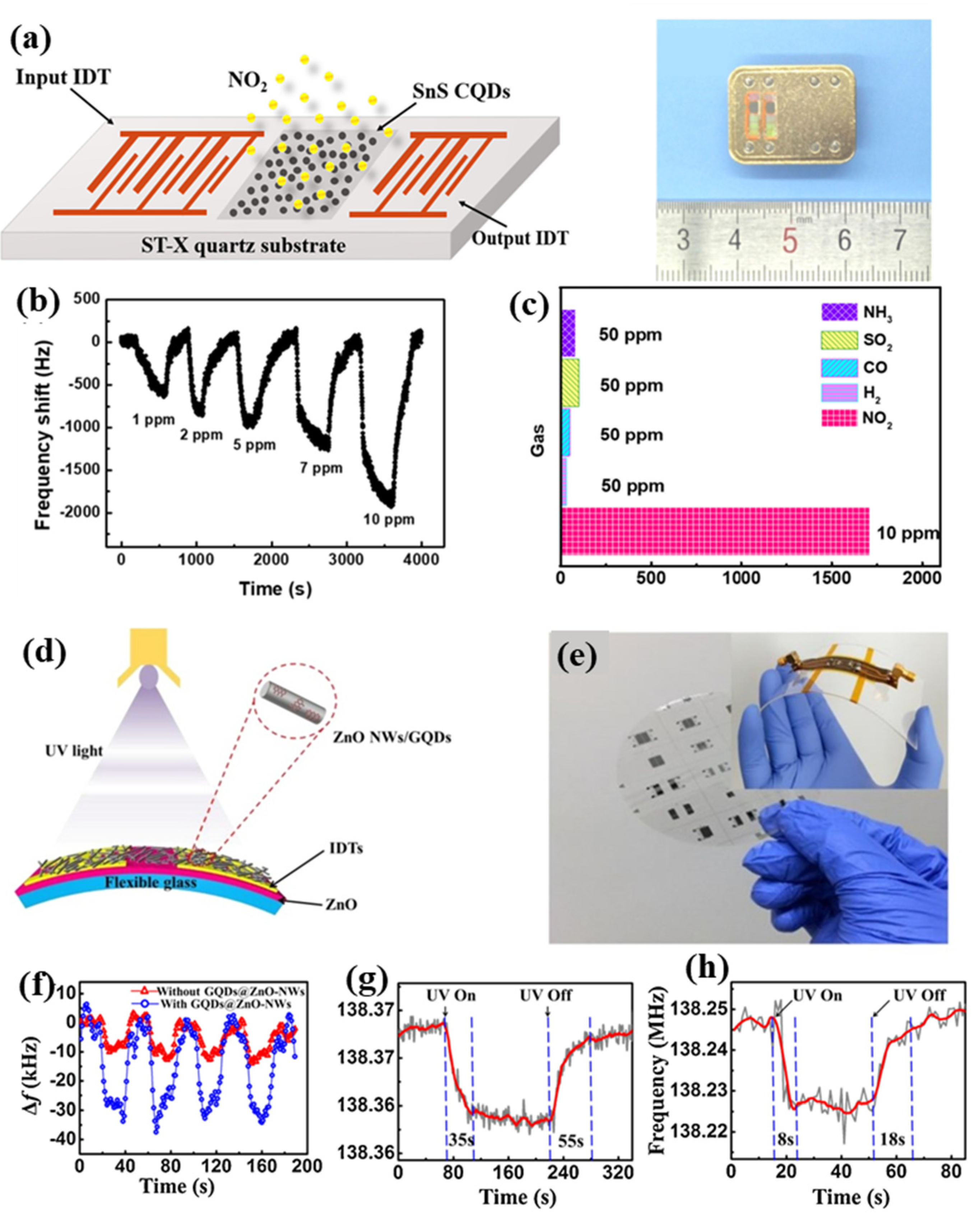
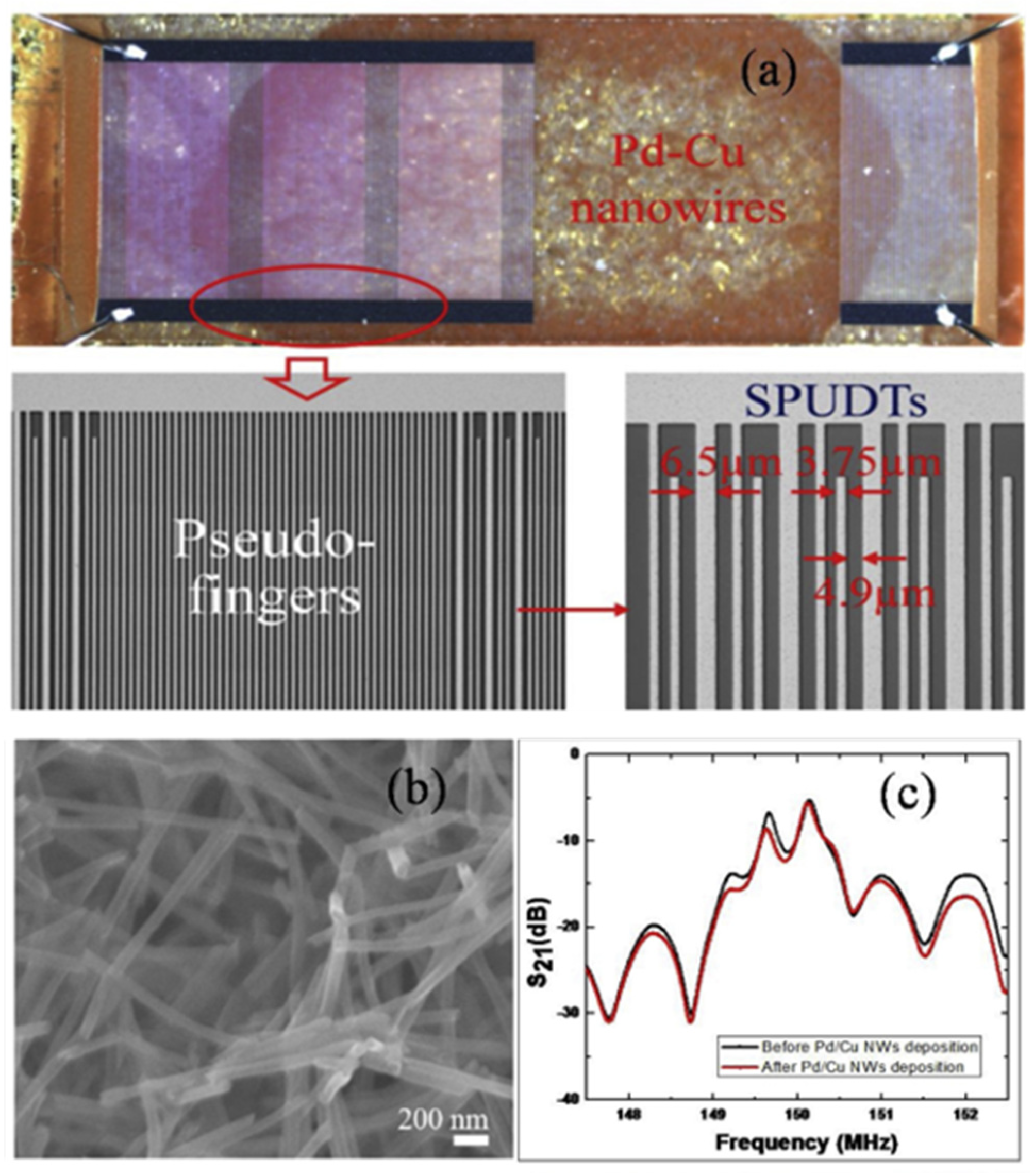

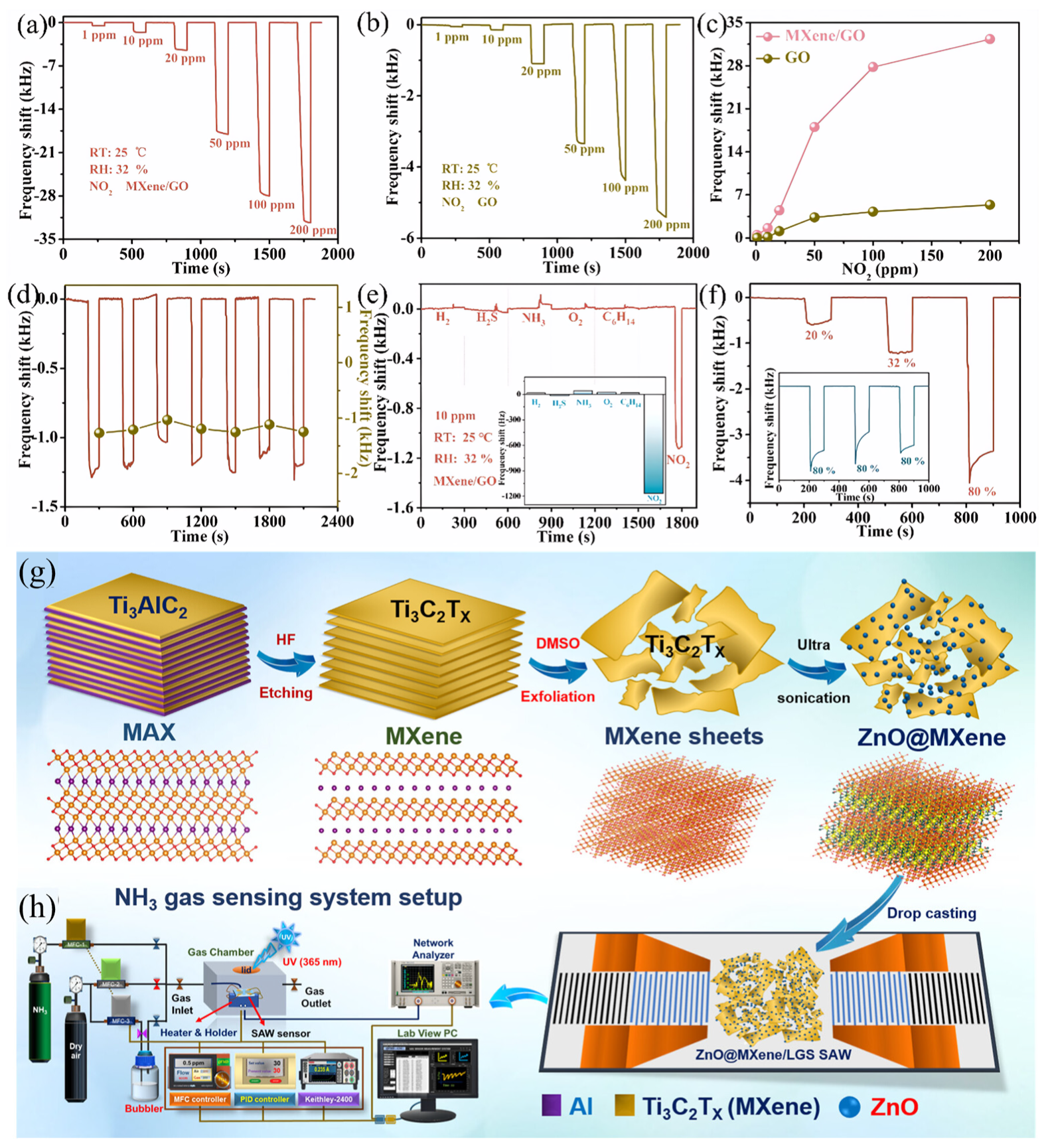
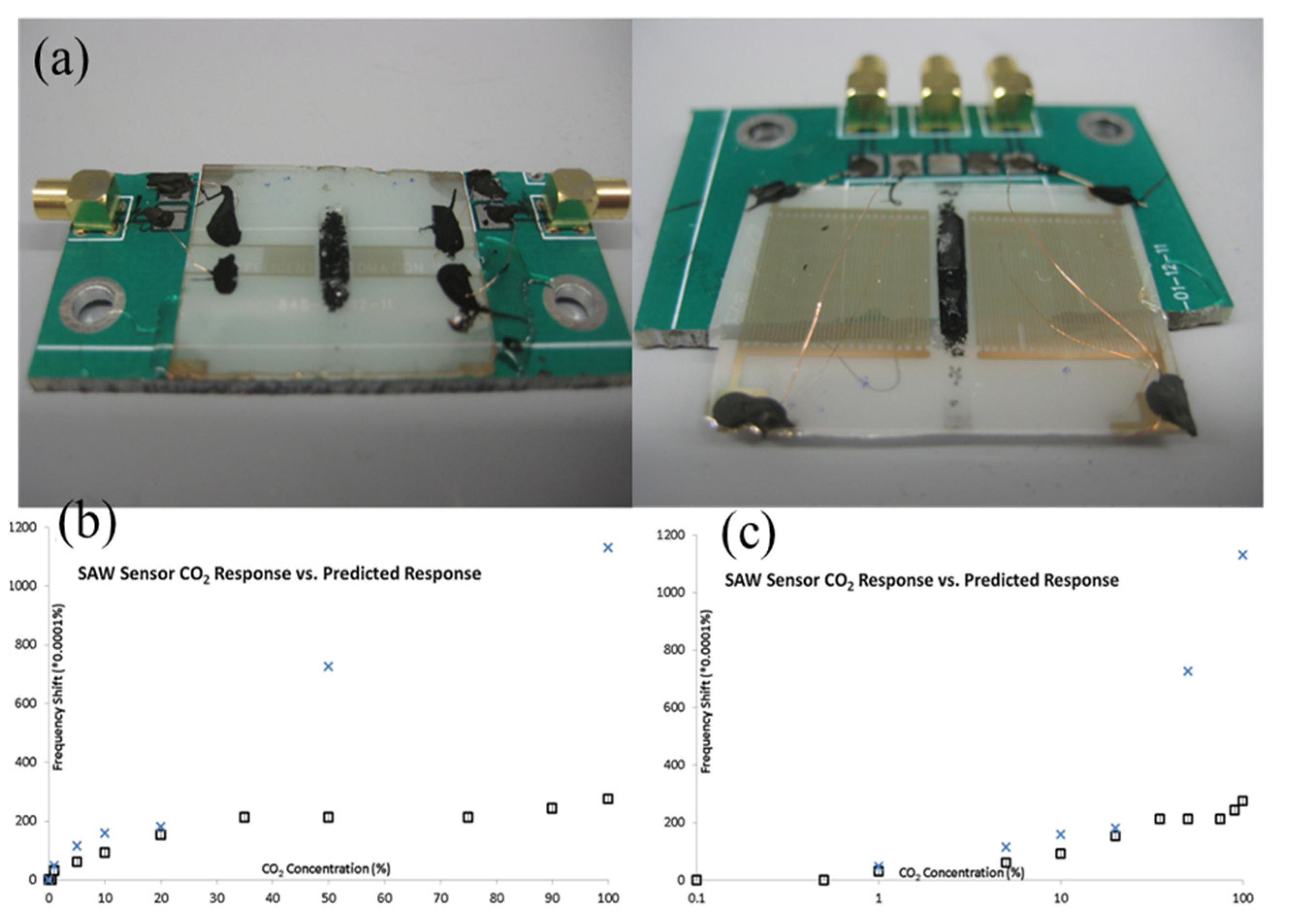
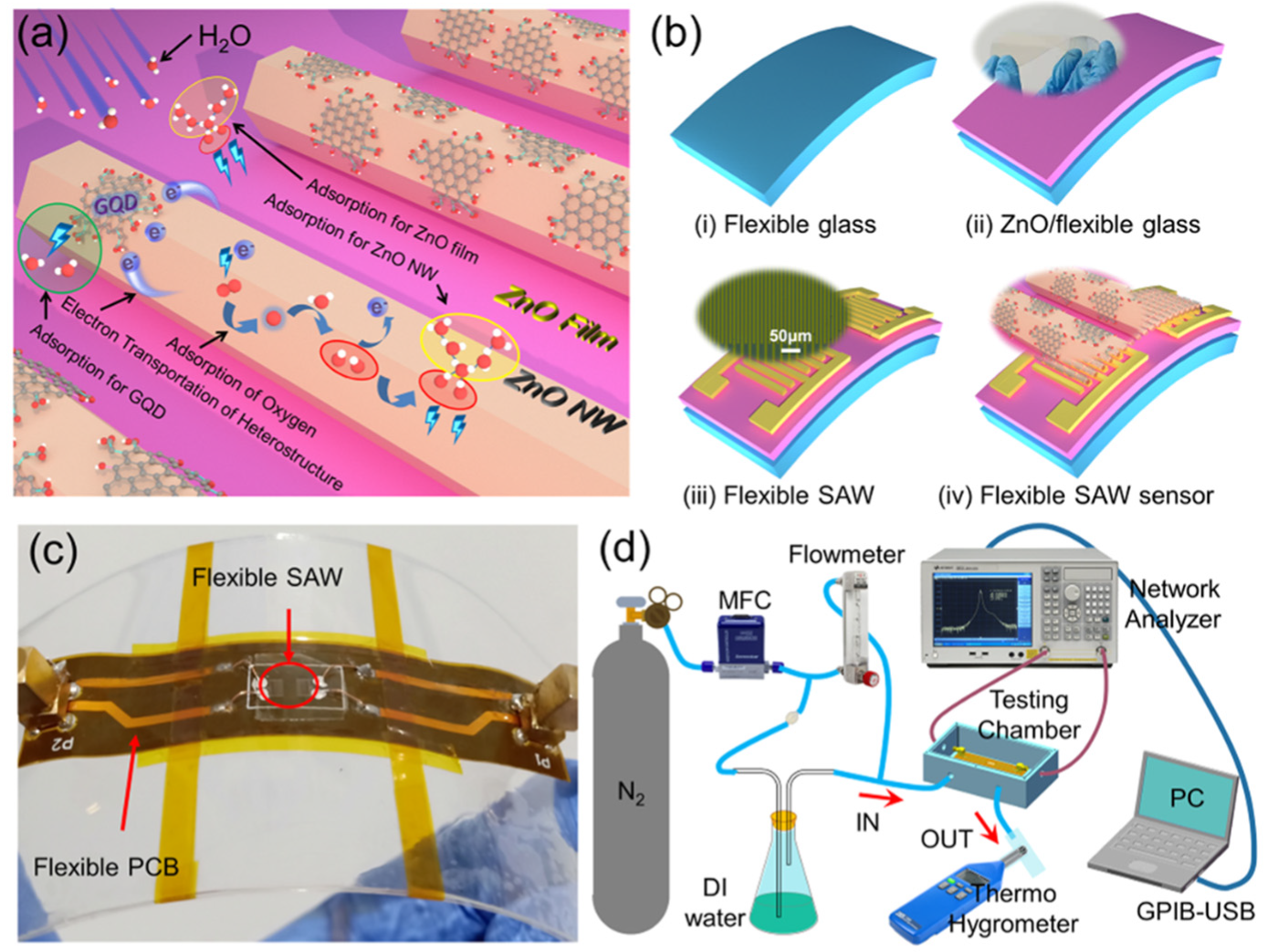

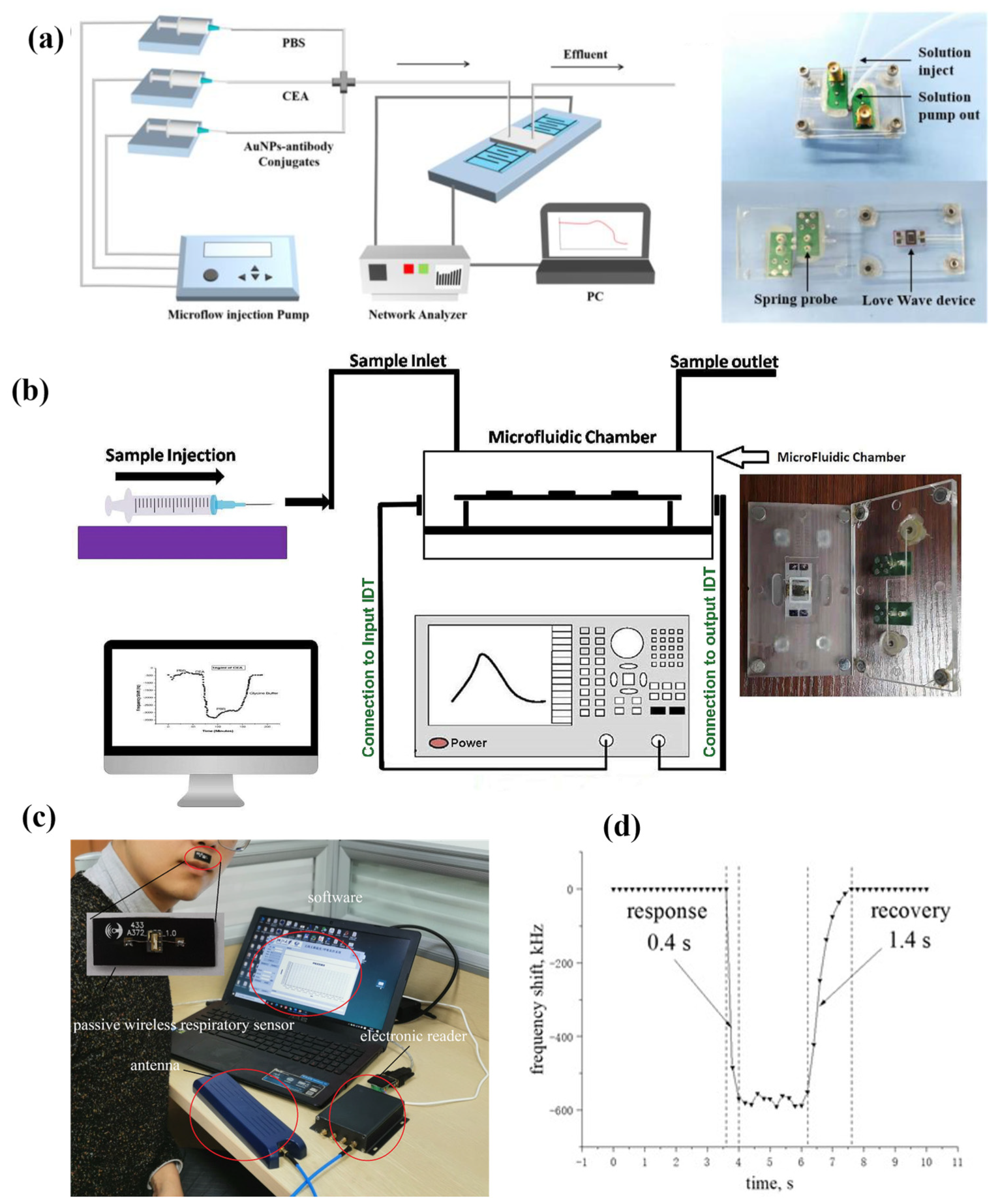
| Materials | ZnO | AlN | ST-Cut Quartz | GaN | 128° Cut LiNbO3 | 36° YX cut LiTaO3 | PVDF |
|---|---|---|---|---|---|---|---|
| Density (103 kg/m3) | 5.61–5.72 | 3.25–3.3 | 2.65 | 6.095–6.15 | 4.64 | 7.45 | 1.78 |
| Young’s modulus (GPa) | 110–140 | 300–350 | 71.7 | 320 | 130–170 | 205 | 2.5 |
| Poisson’s ratio | 0.36 | 0.22–0.29 | 0.17–0.2 | 0.183 | 0.24–0.28 | 0.17–0.2 | 0.33–0.4 |
| Refractive index | 1.9–2.0 | 1.96 | 1.46 | 2.3–2.5 | 2.29 | 2.18 | 1.42 |
| Piezo-constant d33 (pC/N) | 12 | 4.5, 6.4 | 2.3 (d11) | 4.5 | 12 | 12 | −35 |
| Effective coupling coefficient, k2 (%) | 1.5–1.7 | 3.1–8 | 0.1–0.2 | 0.13 | 5–11.3 | 5–6.6 | 2.9 |
| Acoustic velocity of longitudinal (transverse) waves (m/s) | 6336 (2720) | 10,150–11,050 (5800) | 5000–5960 (3159) | 8050 (4130) | 3680–3980 | 4160–4220 | 2600 |
| Dielectric constant | 8.66 | 8.5–10 | 4.3 | ~ | 85 (29) | 54 (43) | 6–8 |
| TCF (ppm/°C) | −40 to −60 | −19 to −25 | 0 | 28.3 | 75 | −30 | |
| Coefficient of thermal expansion (CTE, ×10−6) | 4–6.5 | 5.2 | 1.5 | 3.17 | 15 | −16.5 | 42–75 |
| Inherent material loss(dB·cm−1) | 2.25 (600 MHz) | ~ | 0.85–0.95 (1000 MHz) | ~ | 0.26–0.31 (1000 MHz) | 0.35 (1000 MHz) | ~ |
| CMOS compatible | Incompatible | Compatible | Compatible | ~ | Compatible | ~ | ~ |
| Wave Type | Commonly Used Substrate | Operational Frequency Range | Attenuation | Advantages |
|---|---|---|---|---|
| Rayleigh Wave |
|
|
|
|
| Lamb Wave |
|
|
|
|
| SH-Wave |
|
|
|
|
| Love Wave |
|
|
|
|
| Coating Technique | Applicable Materials | Film Thickness Control | Cost | Temperature Requirements | Advantages | Disadvantages |
|---|---|---|---|---|---|---|
| Spin Coating | Wide range of materials | Moderate control through solution concentration and spin parameters | Inexpensive | Room temperature | Simple, high reproducibility, low cost | Limited to flat substrates, material wastage |
| Inkjet printing | Specially designed inks | Precise control through ink concentration, drop volume, and printing patterns | Inexpensive | Room temperature | Digital patterning, material efficiency, compatible with various substrates | Strict ink requirements, nozzle clogging, limited film thickness |
| CVD | Wide range of materials | Excellent control through precursor flow rates, reaction conditions | Moderate | 600–1000 °C | High-quality films, large-area deposition, controllable thickness and composition | High temperatures, complex process control |
| PLD | Suitable for all types of material phases | Excellent control through laser fluence, deposition time | Expensive | Room temperature to high temperature | High-quality epitaxial films, stoichiometry transfer, low-temperature growth possible | Limited deposition area |
Disclaimer/Publisher’s Note: The statements, opinions and data contained in all publications are solely those of the individual author(s) and contributor(s) and not of MDPI and/or the editor(s). MDPI and/or the editor(s) disclaim responsibility for any injury to people or property resulting from any ideas, methods, instructions or products referred to in the content. |
© 2024 by the authors. Licensee MDPI, Basel, Switzerland. This article is an open access article distributed under the terms and conditions of the Creative Commons Attribution (CC BY) license (https://creativecommons.org/licenses/by/4.0/).
Share and Cite
Lin, Q.; Zhao, C.; Li, M.; Xu, H. Recent Progress in Surface Acoustic Wave Sensors Based on Low-Dimensional Materials and Their Applications. Chemosensors 2024, 12, 255. https://doi.org/10.3390/chemosensors12120255
Lin Q, Zhao C, Li M, Xu H. Recent Progress in Surface Acoustic Wave Sensors Based on Low-Dimensional Materials and Their Applications. Chemosensors. 2024; 12(12):255. https://doi.org/10.3390/chemosensors12120255
Chicago/Turabian StyleLin, Qinhao, Chunxia Zhao, Mingyu Li, and Hao Xu. 2024. "Recent Progress in Surface Acoustic Wave Sensors Based on Low-Dimensional Materials and Their Applications" Chemosensors 12, no. 12: 255. https://doi.org/10.3390/chemosensors12120255
APA StyleLin, Q., Zhao, C., Li, M., & Xu, H. (2024). Recent Progress in Surface Acoustic Wave Sensors Based on Low-Dimensional Materials and Their Applications. Chemosensors, 12(12), 255. https://doi.org/10.3390/chemosensors12120255






